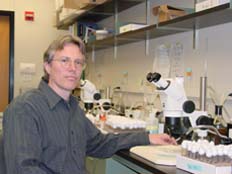Craig M. Hart
Professor
BMB/CDIB Division
PhD: Cornell University
Phone: 225-578-7389
Lab Phone: 225-578-7390
Office: A310 Life Sciences Annex
Lab: A329/A331/A333 Life Sciences Annex
E-mail: chart4@lsu.edu
Area of Interest
Eukaryotic chromosomes are packaged into chromatin, whose repeating nucleosomal substructure is composed of DNA wrapped around histone proteins. Nucleosomes interact with many other proteins to form dynamic, higher-order structures whose forms and functions are poorly understood. My research is focused on the formidable challenge of understanding the role of chromatin dynamics and nuclear organization in essential nuclear processes such as gene expression. My approach integrates the methods of biochemistry, genetics, and molecular cell biology to understand the mechanisms of action of the class of chromosomal elements called chromatin domain insulator elements (also called boundary elements). I am also interested in exploring the possibility that insulators can be developed into useful tools for reducing chromosomal position-effects on transgene expression levels in medical and research applications.
Insulators define possible regulatory interactions within genomes. They block enhancer-promoter communication, but only when located between the enhancer and promoter. Many reviews have been written about insulators proposing mechanisms such as acting as promoter decoys; affecting chromatin structure or dynamics, perhaps by acting as roadblocks that stop the propagation of active or repressed chromatin states; forming anchor points of chromatin loop domains; and localizing to specific subnuclear domains, perhaps helping to organize those domains. To gain insight into molecular mechanisms of insulator function, I am focusing on the role of two proteins I previously purified as well as the insulators to which they bind. These related proteins, called BEAF-32A and BEAF-32B (Boundary Element-Associated Factors of 32 kDa, A form and B form), are produced from the same gene. 32A and 32B interact with each other and bind to sequences present in an abundant class of Drosophila insulators.
Understanding how insulators limit communication between enhancers and promoters will address how enhancers find their target promoters, even when separated by tens of kilobases, without promiscuously interacting with other promoters. The role played by insulators in regulating enhancer-promoter interactions suggests they might play a broader role in the organization of chromosomes into functionally separate domains. Thus, understanding mechanisms governing insulator assembly and function should provide insight into the relationship between higher-order chromatin structure, nuclear organization, and gene regulation.
Selected Publications
McKowen, J.K., Dassanayake, M., Hart, C.M. 2024. The Tofu mutation restores female fertility to Drosophila with a null BEAF mutation. bioRxiv doi: 10.1101/2024.02.13.580197.
McKowen, J.K., Avva, S.V., Maharjan, M., Duarte, F.M., Tome, J.M., Judd, J., Wood , J.L., Negedu, S., Dong, Y., Lis, J.T., Hart, C.M. 2022. The Drosophila BEAF insulator protein interacts with the polybromo subunit of the PBAP chromatin remodeling complex. G3 jkac223. doi: 10.1093/g3journal/jkac223.
Maharjan, M., McKowen, J.K., Hart, C.M. 2020. Overlapping but distinct sequences paly roles in the insulator and promoter activities of the Drosophila BEAF-dependent scs’ insulator. Genetics 215:1003-1012. doi: 10.1534/genetics.120.303344.
Dong, Y., Avva, S.V., Maharjan, M., Jacobi, J., Hart, C.M. 2020. Promoter-proximal chromatin domain insulator protein BEAF mediates local and long-range communication with a transcription factor and directly activates a housekeeping gene in Drosophila. Genetics 215:89-101. doi: 10.1534/genetics.120.303144.
Maharjan, M., Maeda, R.K., Karch, F., Hart, C.M. 2018. Using a phiC31 "Disintegrase" to make new attP sites in the Drosophila genome at locations showing chromosomal position effects. PLoS One. 13(10):e0205538. doi: 10.1371/journal.pone.0205538.
Shrestha, S., Oh, D.H., McKowen, J.K., Dassanayake, M., Hart, C.M. 2018. 4C-seq characterization of Drosophila BEAF binding regions provides evidence for highly variable long-distance interactions between active chromatin. PLoS One. 13(9):e0203843. doi: 10.1371/journal.pone.0203843.
Avva, S.V., Hart, C.M. 2016. Characterization of the Drosophila BEAF-32A and BEAF-32B Insulator Proteins. PLoS One 11(9):e0162906. doi: 10.1371/journal.pone.0162906.
Hart, C.M. 2014. Do the BEAF insulator proteins regulate genes involved in cell polarity and neoplastic growth? Dev. Biol. 389:121-123. doi: 10.1016/j.ydbio.2013.10.031.
Soshnev, A.A., He, B., Baxley, R.M., Jiang, N., Hart, C.M., Tan, K., Geyer, P.K. 2012. Genome-wide studies of the multi-zinc finger Drosophila Suppressor of Hairy-wing protein in the ovary. Nucleic Acids Research 40:5415-5431.
Jiang N., Emberly E., Cuvier O., Hart C.M. 2009. Genome-wide mapping of BEAF binding sites in Drosophila links BEAF to transcription. Mol Cell Bio l. 29:3556-68.
Roy, S., Gilbert, M.K., and Hart, C.M. 2007. Characterization of BEAF mutations isolated by homologous recombination in Drosophila. Genetics 176:801-813.
Gilbert, M.K., Tan, Y.Y., and Hart, C.M. 2006. The Drosophila Boundary Element-Associated Factors BEAF-32A and BEAF-32B affect chromatin structure. Genetics 173:1365-1375.
Kuhn E.J., Hart, C.M., and Geyer, P.K. 2004. Studies of the role of the Drosophila scs and scs' insulators in defining boundaries of a chromosome puff. Mol Cell Biol. 24:1470-80. [cover article]
Müller, J.* , Hart, C.M.*, Francis, N.J.*, Vargus, M.L., Sengupta, A., Wild, B., Miller, E.M., O'Connor, M.B., Kingston, R.E., and Simon, J.A. 2002. Histone methyltransferase activity of a Drosophila Polycomb group repressor complex. Cell 111:197-208. [* These authors contributed equally to this work.]
Hart, C.M., Cuvier, O., and Laemmli, U.K. 1999. Evidence for an antagonistic relationship between the boundary element-associated factor BEAF and the transcription factor DREF. Chromosoma 108:375-383.
Cuvier, O., Hart, C.M., and Laemmli, U.K. 1998. Identification of a class of chromatin boundary elements. Mol. Cell. Biol. 18:7478-7486.
Hart, C.M., Zhao, K., and Laemmli, U.K. 1997. The scs’ boundary element: characterization of boundary element-associated factors. Mol. Cell. Biol. 17:999-1009